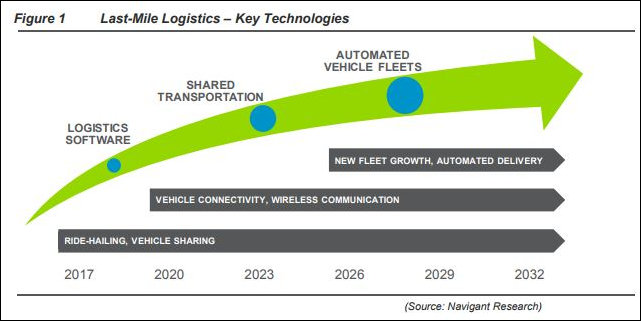
Source: Navigant Research
You know something is destined to become the Next Big Thing when a business research firm like Navigant Research starts charging $1,800 for special reports on the subject. I can’t afford to pay that kind of money, but I do subscribe to Navigant’s alerts to keep tabs on the hottest, most hyped trends in the business world.
Let me introduce two acronyms: MaaS (Mobility as a Service) and LML (Last Mile Logistics). I have discussed mobility as a service several times on this blog — the idea of subscribing to mobility services, such as access to cars, taxi rides, buses, mass transit and even bicycles — rather than owning the transportation assets outright. LML, a new acronym to me, refers to the local delivery of food, small packages and even consumer appliances directly to the home.
The Navigant report, “The Future of Last-Mile Logistics,” explores the intersection of the two. States the executive summary (which is all I have access to):
The biggest challenge today for LML is congestion and parking in large cities. The development of MaaS applications offers a potential solution. In the near future, a MaaS service for a city or local region is likely to deploy a fleet of automated vehicles (ranging from single-person vehicles to minibuses) designed to move large numbers of people to work during rush hour and deliver on-demand transport during off peak hours. This type of fleet would have excess capacity available outside peak hours to perform functions like small parcel and takeout food delivery and would be able to take waste away in bags for recycling or disposal. If the fleet resource is shared effectively, operating single-purpose vehicles for delivery will no longer be necessary for many businesses.
Integrated, shared fleets for MaaS offer the potential for new LML options and delivery cost savings for businesses. Automated driving vehicles are critical for the success of these service models in the long term, while drones have the potential to become a cost-effective solution for deliveries to remote locations.
Got that? Mobility-service companies, be they tech companies like Google and Uber or traditional automobile companies like Ford, General Motors and Mercedes Benz, are preparing for the day when companies operate fleets of driverless cars, vans and buses that operate 24/7. Peak demand for these vehicles will occur during traditional rush hours when people travel between home and work. As demand drops off during the mid-day, cars can be kept busy — and assets continually utilized — by converting them into delivery vehicles.
The potential ramifications are mind-boggling:
- Car ownership. Many people will find it cheaper and preferable to buy the ride rather than own the car. Demand for garages will plummet. (Expect millions of garages to be converted to man caves.)
- Parking. Demand for parking will crater, freeing up tremendous urban and suburban space for conversion to different uses. Walkability will improve in areas with urban density, and low-value parking lots and parking decks will be converted to high-value offices, apartments and condos. urban uses. That’s good for the urban tax base. Suburban localities, with their vast tracts of acreage dedicated to parking, will be most severely impacted, especially if they maintain mandated parking ratios and prevent the land from being recycled.
- Fewer errands. As retailers become more proficient at delivering packages, people will conduct more business online and rely upon home delivery. Insofar as improved home delivery improves the competitive advantage of online retailers, expect further decline of traditional stores and an eventual crisis in retail-oriented real estate development. Dwellings may have to be reconfigured to accept delivery of these items, especially groceries that require refrigeration. Great for renovations contractors and Home Depot!
- Longer commutes. Driverless cars may make long commutes less onerous by allowing “drivers” to surf the web, read email and do work while commuting. Longer commutes could encourage more leapfrog development — to some degree offsetting the competitive advantage to urban areas of less parking.
- Demise of mass transit. Driverless vans and buses will gain market share from mass transit companies with high costs and rigid schedules. Poor people will benefit from the wider range of choices. Mass transit companies will fight for their existence. Urban jurisdictions will face the question: to subsidize or let fail.
These bullet points are all speculative. For all practical purposes, it is impossible to anticipate how the MaaS and LML revolution will pan out. The interactions are too complex for mere mortals to anticipate all possible outcomes.
What we can say for sure is that the transportation future will be very different in 10 to 15 years than it is now. Transportation is a major driving force behind land use, and we can say with equal certainty that land use patterns will be very different as well — although change will come much more slowly.
Here in Virginia, cities and counties that put a premium on flexibility and adaptability will thrive. Those that rigidly adhere to outdated zoning and comprehensive plans will lose.